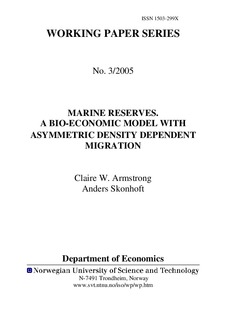| dc.contributor.author | Armstrong, Claire W. | nb_NO |
| dc.contributor.author | Skonhoft, Anders | nb_NO |
| dc.date.accessioned | 2014-12-19T14:31:49Z | |
| dc.date.available | 2014-12-19T14:31:49Z | |
| dc.date.created | 2006-10-03 | nb_NO |
| dc.date.issued | 2005 | nb_NO |
| dc.identifier | 126072 | nb_NO |
| dc.identifier.uri | http://hdl.handle.net/11250/267107 | |
| dc.description.abstract | A static bioeconomic model of a marine reserve allowing asymmetric density dependent migration between the reserve and the fishable area is introduced. This opens for habitat or ecosystem differences allowing different fish densities within and outside a reserve, not described in earlier studies. Four management scenarios are studied; a) maximum harvest, b) maximum current profit, c) open access and d) maximum sustainable yield (MSY) in the reserve. These are all analysed within the Induced Sustainable Yield Function (ISYF), giving the relationship between the fish abundance inside the reserve and the harvesting taking place outside. A numerical analysis shows that management focused on ensuring MSY within the reserve under the assumption of symmetric migration may be negative from an economic point of view, when the area outside the reserve is detrimental compared to the reserve. Furthermore, choice of management option may also have negative consequences for long run resource use if it is incorrectly assumed that density dependent migration is symmetric. The analysis also shows that the optimal area to close, either a more or a less attractive ecosystem for the resource in question, may differ depending on the management goal. | nb_NO |
| dc.language | eng | nb_NO |
| dc.publisher | Institutt for samfunnsøkonomi | nb_NO |
| dc.relation.ispartofseries | Working Paper Series, 1503-299X; 2005:3 | nb_NO |
| dc.title | Marine reserves: A bio-economic model with asymmetric density dependent migration | nb_NO |
| dc.type | Research report | nb_NO |
| dc.contributor.department | Norges teknisk-naturvitenskapelige universitet, Fakultet for samfunnsvitenskap og teknologiledelse, Institutt for samfunnsøkonomi | nb_NO |
